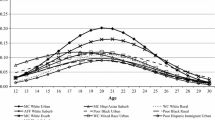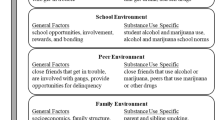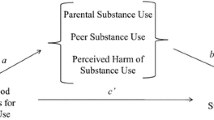Abstract
Risk factors for marijuana use in older adolescents and young adults have focused primarily on family environment and peer affiliation. A growing body of work has examined the relationship between environmental context and young adult substance use. This study builds on previous research linking neighborhood environment to young adult marijuana use by exploring two distinct features of neighborhoods, namely the physical (e.g., broken windows) and social environment (e.g., adults watching youth). Data were obtained from a longitudinal sample of 398 predominately African American young adults living in an urban environment. The data also included observational measures of physical and social order and disorder collected on the young adult’s residential block. Exploratory structural equation modeling (ESEM) was utilized to test hypothesized relationships between these two features of the neighborhood environment and past year young adult marijuana use. A two-factor model of neighborhood environment with good fit indices was selected (CFI = 0.97, RMSEA = 0.037). There was a positive and significant direct effect from neighborhood physical disorder to marijuana use (0.219, p < 0.05) controlling for gender, race, and free and reduced price meal (FARPM) status. The direct effect from neighborhood social environment to marijuana use was not significant. These results converge with previous research linking vacant housing with young adult marijuana use but do not provide empirical support for the neighborhood social environment as a determinant of drug taking. Better explication of the social environment is needed to understand its relationship to drug use.

Similar content being viewed by others
References
Asparouhov, T., & Muthen, B. (2009). Exploratory structural equation modeling. Structural Equation Modeling A Multidisciplinary Journal, 16, 397–438.
Azur, M. J., Stuart, E. A., Frangakis, C., & Leaf, P. J. (2011). Multiple imputation by chained equations: what is it and how does it work? International Journal of Methods in Psychiatric Research, 20, 40–49.
Beauducel, A., & Herzberg, P. Y. (2006). On the performance of maximum likelihood versus means and variance adjusted weighted least squares estimation in CFA. Structural Equation Modeling, 13, 186–203.
Bolland, J. M., Bryant, C. M., Lian, B. E., McCallum, D. M., Vazsonyi, A. T., & Barth, J. M. (2007). Development and risk behavior among African American, Caucasian, and mixed-race adolescents living in high poverty inner-city neighborhoods. American Journal of Community Psychology, 40, 230–249.
Browne, M. W. (2001). An overview of analytic rotation in exploratory factor analysis. Multivariate Behavioral Research, 36, 111–150.
Burlew, A. K., Johnson, C. S., Flowers, A. M., Peteet, B. J., Griffith-Henry, K. D., & Buchanan, N. D. (2009). Neighborhood risk, parental supervision and the onset of substance use among African American adolescents. Journal of Child and Family Studies, 18, 680–689.
Buu, A., DiPiazza, C., Wang, J., Puttler, L. I., Fitzgerald, H. E., & Zucker, R. A. (2009). Parent, family, and neighborhood effects on the development of child substance use and other psychopathology from preschool to the start of adulthood. Journal of Studies on Alcohol & Drugs, 70, 489–498.
Cerdá, M., Tracy, M., Messner, S. F., Vlahov, D., Tardiff, K., & Galea, S. (2009). Misdemeanor policing, physical disorder, and gun-related homicide: a spatial analytic test of “broken-windows” theory. Epidemiology, 20, 533–541.
Cohen, D. A., Mason, K., Bedimo, A., Scribner, R., Basolo, V., & Farley, T. A. (2003). Neighborhood physical conditions and health. American Journal of Public Health, 93, 467–471.
Crum, R. M., Lillie-Blanton, M., & Anthony, J. C. (1996). Neighborhood environment and opportunity to use cocaine and other drugs in late childhood and early adolescence. Drug and Alcohol Dependence, 43, 155–161.
Eaton, D. K., Kann, L., Kinchen, S., Shanklin, S., Flint, K. H., Hawkins, J., et al. (2012). Youth risk behavior surveillance—United States, 2011. Morbidity and Mortality Weekly Report Surveillance Summary, 61, 1–162.
Fergusson, D. M., Horwood, L. J., & Swain-Campbell, N. (2002). Cannabis use and psychosocial adjustment in adolescence and young adulthood. Addiction Abingdon England, 97, 1123–1135.
Fischer, C. S., Stockmayer, G., Stiles, J., & Hout, M. (2004). Distinguishing the geographic levels and social dimensions of U.S. metropolitan segregation, 1960–2000. Demography, 41, 37–59.
Foster, H., & Brooks-Gunn, J. (2013). Neighborhood influences on antisocial behavior during childhood and adolescence. In C. L. Gibson & M. D. Krohn (Eds.), Handbook of life-course criminology (pp. 69–90). New York: Springer.
Furr-Holden, C. D. M., Ialongo, N. S., Anthony, J. C., Petras, H., & Kellam, S. G. (2004). Developmentally inspired drug prevention: middle school outcomes in a school-based randomized prevention trial. Drug and Alcohol Dependence, 73, 149–158.
Furr-Holden, C. D. M., Smart, M. J., Pokorni, J. L., Ialongo, N. S., Leaf, P. J., Holder, H. D., & Anthony, J. C. (2008). The NIfETy method for environmental assessment of neighborhood-level indicators of violence, alcohol, and other drug exposure. Prevention Science, 9, 245–255.
Furr-Holden, C. D. M., Campbell, K., Milam, A. J., Smart, M. J., Ialongo, N. S., & Leaf, P. J. (2010). Metric properties of the Neighborhood Inventory for Environmental Typology (NIfETy): an environmental assessment tool for measuring indicators of violence, alcohol, tobacco, and other drug exposures. Evaluation Review, 34, 159–184.
Furr-Holden, C. D. M., Lee, M. H., Milam, A. J., Johnson, R. M., Lee, K.-S., & Ialongo, N. S. (2011). The growth of neighborhood disorder and marijuana use among urban adolescents: a case for policy and environmental interventions. Journal of Studies on Alcohol and Drugs, 72, 371–379.
Gary, T. L., Stark, S. A., & LaVeist, T. A. (2007). Neighborhood characteristics and mental health among African Americans and whites living in a racially integrated urban community. Health & Place, 13, 569–575.
Glaeser, E. L., & Vigdor, J. L. (2001). Racial segregation in the 2000 Census: promising news. Brookings Institution Survey Series. Washington: Brookings Institution. Retrieved from: http://www.brookings.edu/~/media/Files/rc/reports/2001/04demographics_edward%20l%20%20glaeser%20and%20jacob%20l%20%20vigdor/glaeser.pdf.
Graham, J. W. (2009). Missing data analysis: making it work in the real world. Annual Review of Psychology, 60, 549–576.
Jeffery, C. R. (1971). Crime prevention through environmental design. California: Sage.
Jeffery, C. R. (1990). Criminology: an interdisciplinary approach. New Jersey: Prentice-Hall.
Jeffery, C. R., & Zahm, D. L. (1993). Crime prevention through environmental design, opportunity theory, and rational choice models. In R. V. Clark & M. Felson (Eds.), Routine activity and rational choice. Advances in criminological theory, vol. 5. New Jersey: Transaction Publishers.
Lambert, S. F., Brown, T., Phillips, C. M., & Ialongo, N. S. (2004). The relationship between perceptions of neighborhood characteristics and substance use among urban African American adolescents. American Journal of Community Psychology, 34, 205–218.
Lessem, J. M., Hopfer, C. J., Haberstick, B. C., Timberlake, D., Ehringer, M. A., Smolen, A., & Hewitt, J. K. (2006). Relationship between adolescent marijuana use and young adult illicit drug use. Behavior Genetics, 36, 498–506.
Leventhal, T., & Brooks-Gunn, J. (2000). The neighborhoods they live in: the effects of neighborhood residence on child and adolescent outcomes. Psychological Bulletin, 126, 309–337.
Little, R. J., & Rubin, D. B. (1987). Statistical analysis with missing data. New York: J. Wiley & Sons.
Mair, J. S., & Mair, M. (2003). Violence prevention and control through environmental modifications. Annual Review of Public Health, 24, 209–225.
Marsh, H. W., Muthén, B., Asparouhov, T., Lüdtke, O., Robitzsch, A., Morin, A. J. S., & Trautwein, U. (2009). Exploratory structural equation modeling, integrating CFA and EFA: application to students’ evaluations of university teaching. Structural Equation Modeling A Multidisciplinary Journal, 16, 439–476.
Mauricio, A. M., Little, M., Chassin, L., Knight, G. P., Piquero, A. R., Losoya, S. H., & Vargas-Chanes, D. (2009). Juvenile offenders’ alcohol and marijuana trajectories: risk and protective factor effects in the context of time in a supervised facility. Journal of Youth and Adolescence, 38, 440–453.
McAdams, T., Rowe, R., Rijsdijk, F., Maughan, B., & Eley, T. C. (2012). The covariation of antisocial behavior and substance use in adolescence: a behavioral genetic perspective. Journal of Research on Adolescence, 22, 100–112.
Muthén, L. K., Muthén, B. O. (1998–2010). Mplus user’s guide (6th ed.). Los Angeles, CA: Author.
Perkins, D. D., Meeks, J. W., & Taylor, R. B. (1992). The physical environment of street blocks and resident perceptions of crime and disorder: implications for theory and measurement. Journal of Environmental Psychology, 12, 21–34.
Perkins, D. D., Brown, B. B., & Taylor, R. B. (1996). The ecology of empowerment: predicting participation in community organizations. Journal of Social Issues, 52, 85–110.
Reboussin, B. A., Hubbard, S., & Ialongo, N. S. (2007). Marijuana use patterns among African-American middle-school students: a longitudinal latent class regression analysis. Drug and Alcohol Dependence, 90, 12–24.
Roosa, M. W., Jones, S., Tein, J.-Y., & Cree, W. (2003). Prevention science and neighborhood influences on low-income children’s development: theoretical and methodological issues. American Journal of Community Psychology, 31, 55–72.
Rubin, D. B. (1987). Multiple imputation for nonresponse in surveys. New York: John Wiley & Sons.
Sampson, R. J., Raudenbush, S. W., & Earls, F. (1997). Neighborhoods and violent crime: a multilevel study of collective efficacy. Science, 277, 918–924.
Snedker, K. A., Herting, J. R., & Walton, E. (2013). Neighborhood resources and adolescent health and risk behaviors. In N. Hoque, M. A. McGehee, & B. S. Bradshaw (Eds.), Applied demography and public health (pp. 215–229). Netherlands: Springer.
StataCorp. (2009). Stata statistical software: Release 11. College Station: StataCorp LP.
Substance Abuse and Mental Health Services Administration. (2010). Results from the 2009 national survey on drug use and health: volume I. Summary of national findings (HHS Publication No. SMA 10–4856). Rockville: Office of Applied Studies.
Tarter, R. E., Kirisci, L., Ridenour, T., & Vanyukov, M. (2008). Prediction of cannabis use disorder between childhood and young adulthood using the Child Behavior Checklist. Journal of Psychopathology and Behavioral Assessment, 30, 272–278.
Tarter, R. E., Kirisci, L., Gavaler, J. S., Reynolds, M., Kirillova, G., Clark, D. B., Wu, J., et al. (2009). Prospective study of the association between abandoned dwellings and testosterone level on the development of behaviors leading to cannabis use disorder in boys. Biological Psychiatry, 65, 116–121.
Taylor, R. B., Gottfredson, S. D., & Brower, S. (1984). Block crime and fear: defensible space, local social ties, and territorial functioning. Journal of Research in Crime and Delinquency, 21, 303–331.
Theall, K. P., Sterk, C. E., & Elifson, K. W. (2009). Perceived neighborhood fear and drug use among young adults. American Journal of Health Behavior, 33, 353–365.
Tucker, J. S., Pollard, M. S., de la Haye, K., Kennedy, D. P., & Green, H. D., Jr. (2013). Neighborhood characteristics and the initiation of marijuana use and binge drinking. Drug and Alcohol Dependence, 128, 83–89.
Wasserman, I. M., & Stack, S. (2008). Lethal locations: an application of opportunity theory to motel suicide, a research note. Death Studies, 32, 757–767.
Windle, M., & Wiesner, M. (2004). Trajectories of marijuana use from adolescence to young adulthood: predictors and outcomes. Development and Psychopathology, 16, 1007–1027.
Winstanley, E. L., Steinwachs, D. M., Ensminger, M. E., Latkin, C. A., Stitzer, M. L., & Olsen, Y. (2008). The association of self-reported neighborhood disorganization and social capital with adolescent alcohol and drug use, dependence, and access to treatment. Drug and Alcohol Dependence, 92, 173–182.
Yu, C. Y. (2002). Evaluating cutoff criteria of model fit indices for latent variable models with binary and continuous outcomes (doctoral dissertation).
Grant Support
This work was supported by the National Institute on Alcoholism and Alcohol Abuse (NIAAA) R01AA015196; the National Institute on Drug Abuse (NIDA) R37-DA0011796, NIDA Grant DA032550; grant NIDA KOI-DA31738 and the Centers for Disease Control and Prevention (CDC) 1U01CE001954-01A1.
Author information
Authors and Affiliations
Corresponding author
Rights and permissions
About this article
Cite this article
Furr-Holden, C.D.M., Lee, M.H., Johnson, R. et al. Neighborhood Environment and Marijuana Use in Urban Young Adults. Prev Sci 16, 268–278 (2015). https://doi.org/10.1007/s11121-014-0497-8
Published:
Issue Date:
DOI: https://doi.org/10.1007/s11121-014-0497-8




